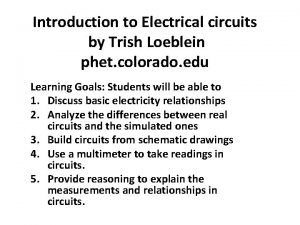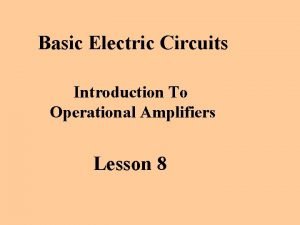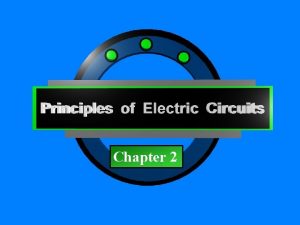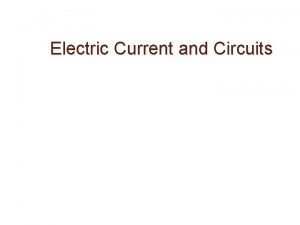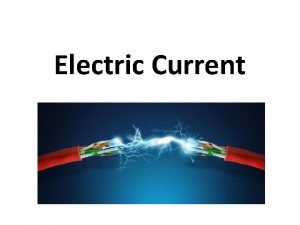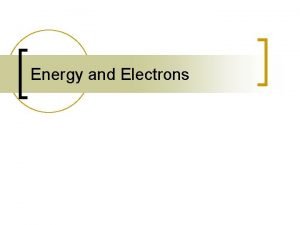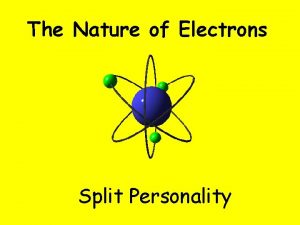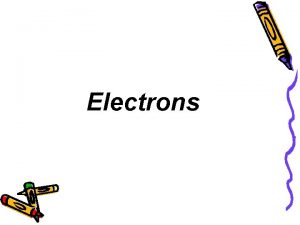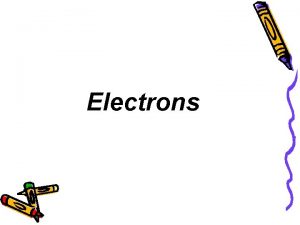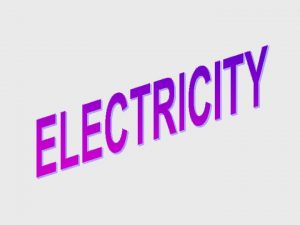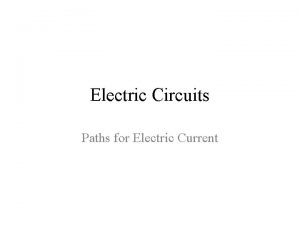ELECTRIC CIRCUITS I Circuits A flow of electrons













- Slides: 13

ELECTRIC CIRCUITS

I. Circuits �A flow of electrons is called a current. Symbol - I Unit is Amperes or Amps (A) I = q/t �Current is amount of charge per time.

B. What is a circuit? �A circuit is any closed loop or conducting path allowing electric charge to flow. Closed loop – circuit is ON Open loop – circuit is OFF

II. Electrical Potential Difference �It is the work done moving a charge through an electric field. �Symbol V V = Won q /q or V=kq/r Measured in Volts It is the push required to move electrons through a circuit.

III. Resistance �A property of materials that is a measurement of how much electricity will flow. The higher the resistance the less electricity will flow. Measured in Ohms ( ) OHM’S Law �V=I R �THIS WILL BE LAB #1

OTHER FORMULAS 2 �P=I R 2 �P = V /R �P = IV �This is electrical power measured in Watts. (W) Don’t forget that P=Work/time as well, and work is energy (in this case-electrical).

III. Resistance again �Every substance has a certain amount of resistance. �It depends on: LENGTH (L) CROSS SECTIONAL AREA (A) TYPE OF SUBSTANCE (called resistivity) � Symbol = �R = (L/A) THIS WILL BE LAB #2

IV. TYPES OF CIRCUITS �Each circuit has a series of symbols in order to make a schematic. �A schematic is a drawing of a circuit in order to build it. �Symbols: wire cell ammeter light bulb switch voltmeter resistor

EXAMPLE CIRCUIT

SERIES CIRCUIT �Only ONE path for the electricity to flow! �This will be lab #3 #1 #2 #3

PARALLEL CIRCUIT �Multiple paths for the electricity to flow. �This will e lab #4 #1 #2 #3

COMBINATION CIRCUITS �Has properties of both series and parallel. �This will be lab #5 #1 #2 #4 #3

Rules for these circuits will be derived by YOU during the labs you will be doing!
 Series parallel circuit current
Series parallel circuit current Phet circuit
Phet circuit Fundamentals of electric circuits chapter 4 solutions
Fundamentals of electric circuits chapter 4 solutions Electric current
Electric current Conceptual physics chapter 35
Conceptual physics chapter 35 Chapter 20 electric circuits
Chapter 20 electric circuits Electric circuits equations
Electric circuits equations The circuit chapter 9
The circuit chapter 9 Fundamentals of electric circuits chapter 7 solutions
Fundamentals of electric circuits chapter 7 solutions Chapter 35 electric circuits answers
Chapter 35 electric circuits answers Electric circuits by james nilsson and susan riedel
Electric circuits by james nilsson and susan riedel Circuits ohm's law worksheet answers
Circuits ohm's law worksheet answers Principle of electric circuit
Principle of electric circuit Electrical circuit elements
Electrical circuit elements

